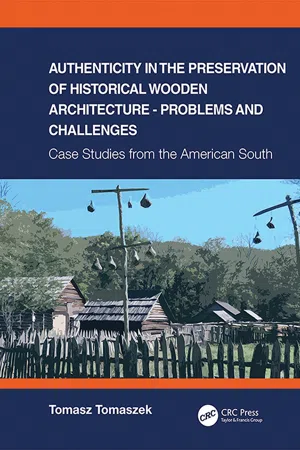
Authenticity in the Preservation of Historical Wooden Architecture - Problems and Challenges
Case Studies from the American South
- 146 pages
- English
- ePUB (mobile friendly)
- Available on iOS & Android
Authenticity in the Preservation of Historical Wooden Architecture - Problems and Challenges
Case Studies from the American South
About This Book
Historical wooden architecture is one of the most unique types of heritage built. Built from organic material, wooden buildings remain in harmony with the natural environment and fascinate future generations with its special charm. Because of its uniqueness, wooden buildings reflect the richness of traditional building solutions developed in different parts of the world. At the same time, this type of building contains the spiritual values ??that were important to those who built these architectural structures.
The main topics of 'Authenticity in Preserving Historical Wooden Architecture - Problems and Challenges' are:
(i) The method of protection and preservation of wooden buildings as a form of specific historical interpretation;
(ii) The question of reconstruction and translocation of a wooden historical building with regard to the level of authenticity;
(iii) The analysis of the essence of historical changes and the methods for maintaining and displaying wooden structures in relation to the requirements that determine their historical and architectural authenticity.
Showing a variety of aspects of authenticity of wooden buildings, all demonstrated by specific examples (case studies), 'Authenticity in Preserving Historical Wooden Architecture - Problems and Challenges' presents practical implementations of theoretical findings. Hence, the book contributes to the understanding of wooden architectural heritage from a new perspective. The book will be of particular interest to academics and professionals interested in or involved in the preservation of built wooden heritage.
Frequently asked questions
Information
The preliminary recognition of the condition and authenticity of historical log structures remaining in Cane Ridge community (Antioch, Tennessee)
1 INTRODUCTION
2 HISTORICAL LOG STRUCTURES IN THE CANE RIDGE COMMUNITY
Table of contents
- Cover
- Half Title
- Title Page
- Copyright Page
- Table of Contents
- Preface
- About the author
- A critical study of the search for authenticity and significance in historic wooden buildings
- Issue of the reconstruction of wooden log cabins as a part of the interpretation of historically significant places in West and Middle Tennessee – case studies of Parkers Crossroads, Meriwether Lewis Monument and Shiloh National Military Park
- The preliminary recognition of the condition and authenticity of historical log structures remaining in Cane Ridge community (Antioch, Tennessee)
- Reconstruction of a group of historic wooden buildings and the authenticity of the architectural heritage structure – a case study of Wynnewood, Tennessee
- Authenticity versus interpretation – issues of the preservation of historical wooden buildings using the example of The Tipton-Haynes Historic Site and The Historic Sam Davis Home and Plantation, significant historic farms in Tennessee.